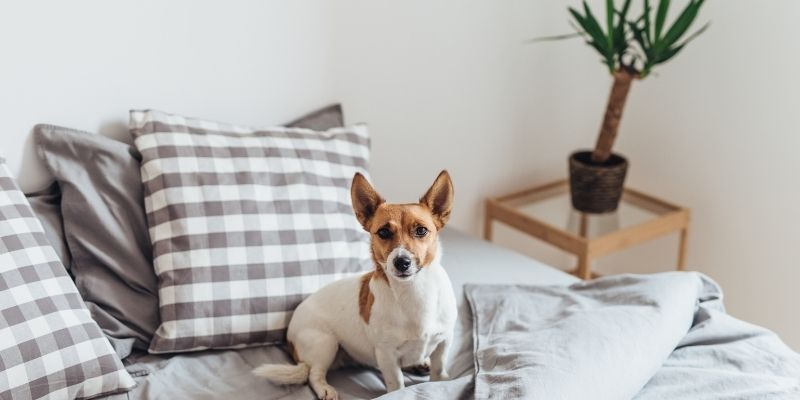Why exactly are our canines scratching on their dog bed, or carpet, or even on our beds?! There are a few reasons, actually. It can be because of anxiety, maternal instincts, and their natural desire of being territorial. Just to name a few.
Regardless of the reason, if you have a canine prone to scratching, you might want to invest in a good dog bed, a calming one especially.
If you would just like a quick recommendation for the best calming dog bed, I would go for a calming bed like one. Its shape is ideal for pets that love to just curl up.
There is a comfortable burrow with a surrounding wall where they can comfortably lay their head. It’s cozy, fluffy, and of great quality with safe materials—vegan faux shag fur.
So why do dogs scratch their bed?
The first reason why dogs scratch their bed is that it is a natural instinct. We tend to forget that dogs’ ancestors roamed in the wild, scratching piles of dirt, leaves, sticks, rocks, or pine needles to create a comfortable set up, which is their bed. This ‘nest’ that they build would have to be comfortable for uniform positions and act as protection against any predators.
Using whatever material is available around them, they can build protection and make themselves feel less vulnerable. The burrowing under leaves and dirt translates today as burrowing under their beds, toys, or blankets.

Another reason is to investigate. Dogs may also be ‘digging’ through their beds rather than scratching it. The motion they’re doing might be just that, even doing a funny jump or hop on top of their dog beds. They may do this simply to investigate and see what is there.
One other reason may be anxiety. Fingers crossed this won’t be the case for your beloved pet, but dogs do, in fact, do this as a displacement behavior when they are anxious. If they do it often, and not just in areas where they usually stay, then best observe them for some time.
Suppose they exhibit other behaviors such as scratching themselves or being restless and moving around the home too much. In that case, I recommend you discuss this with your vet if there are some underlying health issues.

Why does my dog scratch my bedsheets?
Sure, dogs may have their own beds, but that doesn’t stop them from climbing up on your bed. One reason they may be doing this is that they are territorial. Naturally, dogs want to mark their territory, claiming everything around them as their own. You may notice the same thing when dogs urinate outside. They do so in spots where they smell other dogs have ‘marked’ their territory.

To explain further, dogs have glands in their paws, which leave their scent on objects. Hence, when they scratch your sheets, they may also be leaving their scent. In fact, dogs go back to a spot continuously once they feel they have made it their own.
So to summarize, if your dogs scratch your sheets, this means:
- they want to be comfortable
- they want to make your bed their territory.
See it as a compliment. They feel so at home on your beds already!

Why do dogs scratch before lying down?

As I’ve mentioned before, dogs may scratch their beds before lying down to make it more comfortable. Think of it this way: we humans also adjust, fix, and alter our pillows’ position before lying down.
We do this because we are simply not satisfied with certain sleeping positions and even move many times a night. Come to think of it, if we even have a lot of pillows, we tend to move those around too.
Another reason why dogs scratch their bed is that it is a learned habit. This is especially true if you have a new puppy or a new dog in the house. Dogs tend to mimic each other. Hence, the new dog may just pick it up and see it as normal.

More about dogs’ nesting behavior

Another main reason that dogs scratch their beds is because of their maternal instincts. If your female dog is expecting, she will most likely scratch the beds increasingly more often in preparation for their arrival.
This is what we call ‘nesting.’ In short, they are making a nest for her new pups to make them feel comfortable, warm, and safe. Other nesting behavior is dragging blankets to new spots, digging into small spaces, or shredding blankets to make their own spot their own. Even dogs that aren’t pregnant will do this just to feel comfortable.
However, we must mention that nesting may be a behavior associated with a severe sickness. A serious illness increases your dog’s chance of experiencing a false pregnancy, which causes your dog to nest. False pregnancy, by the way, is when your dog thinks she’s pregnant. If your female dog’s nest, along with shredding blankets or over-grooming, they may be pregnant.

How to get a dog to stop scratching the bed?
First off, if you know, you’re getting a new dog and want them to not scratch their bed, then best train them at an early age. Anyone who is a new puppy owner knows that you basically have to follow them around to discipline them of the house’s rules— e.g. through positive and negative reinforcement. This way, they learn it while they are young.

Other ways are to add more blankets to create a softer texture or getting a thicker blanket so that they don’t scratch or damage their bed. This is the most apparent method. You are basically just layering up and giving your dog more material to work with.
You could also try to relocate their bed to a private area to strictly know and get used to their own space in the house. Of course, you could also invest in a reliable, durable bed built for your dog’s scratching habit.
Evidently, if your dog is scratching your bed or furniture too much, then you can always just hiss or tell them off in a firm tone to get your message across.

And do I really need to do it?
Dogs will be dogs. At the end of the day, they are animals, and there is really no need for you to stop them from scratching the bed—at least, not their bed. In case your dog is seriously putting some efforts into scratching beds, couches, and bedding, then yes, you may want to stop them.
Of course, this is all up to you and how careful you are with your belongings. A dog’s scratching behavior is quite innocent and does not mean it is a sign of aggression or violent behavior.
Thanks for the blog graphics: Canva.com


